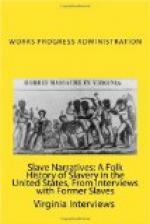“The house had two rooms about eight feet apart. The rooms were connected by a hall which we called a gallery in those days. The hall was covered by the same roof as the house and it had the same floor. The house sot east and west and had a chimney in each end. The chimneys were made out of sticks and mud. I can build a chimney now like that.
“It was large at the bottom and tapered at the top. It was about six or seven feet square at the bottom. It grew smaller as it went toward the top. You could get a piece of wood three and a half or four feet long in the boddom of it. Sometimes the wood would be too large to carry and you would just have to roll it in.
“The floors was boards about one by twelve. There were two doors in each room—one leading outside and the other to the hall. If there were any windows, I can’t remember them. We didn’t need no windows for ventilation.
“This was the house that I remember first after freedom. I remember living in it. That was about seven or eight years after freedom. My father rented it from the big man named Alf George for whom he worked. Mr. George used to come out and eat breakfast with us. We’d get that hoecake out of the ashes and wash it off until it looked like it was as clean as bread cooked in a skillet. I have seen my grandmother cook a many a one in the fire. We didn’t use no skillet for corn bread. The bread would have a good firm crust on it. But it didn’t get too hard to eat and enjoy.
“She’d take a poker before she put the bread in and rake the ashes off the hearth down to the solid stone or earth bottom, and the ashes would be banked in two hills to one side and the other. Then she would put the batter down on it; the batter would be about an inch thick and about nine inches across. She’d put down three cakes at a time and let ’em stay there till the cakes were firm—about five minutes on the bare hot hearth. They would almost bake before she covered them up. Sometimes she would lay down as many as four at a time. The cakes had to be dry before they were covered up, because if the ashes ever stuck to them while they were wet, there would be ashes in them when you would take them out to eat. She’d take her poker then and rake the ashes back on the top of the cakes and let ’em stay there till the cakes were done. I don’t know just how long—maybe about ten or twelve minutes. She knew how long to cook them. Then she’d rake down the hearth gently, backward and forward, with the poker till she got down to them and then she’d put the poker under them and lift them out. That poker was a kind of flat iron. It wasn’t a round one. Then we’d wash ’em off like I told you and they be ready to eat.
“Mr. George would eat the ash cake and drink sweet milk. ’Auntie, I want some of that ash cake and some of that good sweet milk.’ We had plenty of cows.
“Two-thirds of the water used in the ash cake was hot water, and that made the batter stick together like it was biscuit dough. She could put it together and take it in her hand and pat it out flat and lay it on the hearth. It would be just as round! That was the art of it!




